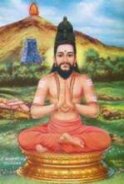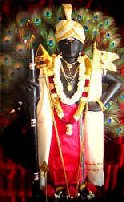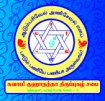

திரு அருணகிரிநாதர் அருளிய
திருப்புகழ்
Sri AruNagirinAthar's
Thiruppugazh

 |  திரு அருணகிரிநாதர் அருளிய Sri AruNagirinAthar's |  |
|---|
| திருப்புகழ் 998 நாலிரண்டிதழாலே (பொதுப்பாடல்கள்) Thiruppugazh 998 nAliraNtidhazhAlE (common) |
 |  | தமிழிலும் ஆங்கிலத்திலும் பொருள் எழுதியது ஸ்ரீ கோபால சுந்தரம் Meanings in Tamil and English by Sri Gopala Sundaram | English in PDF PDF அமைப்பு | ஆலய வரிசை அகரவரிசை எண்வரிசை தேடல் venue list alphabetical numerical search |
|
தான தந்தன தானா தானன தான தந்தன தானா தானன தான தந்தன தானா தானன ...... தனதான ......... பாடல் ......... நாலி ரண்டித ழாலே கோலிய ஞால முண்டக மேலே தானிள ஞாயி றென்றுறு கோலா காலனு ...... மதின்மேலே ஞால முண்டபி ராணா தாரனும் யோக மந்திர மூலா தாரனு நாடி நின்றப்ர பாவா காரனு ...... நடுவாக மேலி ருந்தகி ரீடா பீடமு நூல றிந்தம ணீமா மாடமு மேத கும்ப்ரபை கோடா கோடியு ...... மிடமாக வீசி நின்றுள தூபா தீபவி சால மண்டப மீதே யேறிய வீர பண்டித வீரா சாரிய ...... வினைதீராய் ஆல கந்தரி மோடா மோடிகு மாரி பிங்கலை நானா தேசிய மோகி மங்கலை லோகா லோகியெ ...... வுயிர்பாலும் ஆன சம்ப்ரமி மாதா மாதவி ஆதி யம்பிகை ஞாதா வானவ ராட மன்றினி லாடா நாடிய ...... அபிராமி கால சங்கரி சீலா சீலித்ரி சூலி மந்த்ரச பாஷா பாஷணி காள கண்டிக பாலீ மாலினி ...... கலியாணி காம தந்திர லீலா லோகினி வாம தந்திர நூலாய் வாள்சிவ காம சுந்தரி வாழ்வே தேவர்கள் ...... பெருமாளே. ......... சொல் விளக்கம் ......... நாலிரண்டு இதழாலே கோலிய ஞால் அம் முண்டகம் மேலே ... ஆறு இதழ்த் தாமரையால் வகுக்கப்பட்ட, தொங்கிப் பொருந்தி உள்ள அந்தத் தாமரையின் மேல் உள்ள (சுவாதிஷ்டானம் என்னும்) ஆதார நிலையில், தான் இள ஞாயிறு என்று உறு கோலா காலனும் ... உதிக்கும் செஞ் சூரியன் என்று சொல்லும்படியான செம்பொன் நிறமுள்ள, ஆடம்பரமான பிரமனும், அதின் மேலே ஞாலம் உண்ட பிராண ஆதாரனும் ... அந்த ஆதாரத்தின் மேல் நிலையில் (மணி பூரகம் என்னும் ஆதார நிலையில் உள்ள) பூமியை உண்டவரும், உயிர்களைக் காக்கும் தொழிலைக் கொண்டவருமாகிய திருமாலும், யோக மந்திர மூலாதாரனு(ம்) ... யோகத்துக்கும் மந்திரங்களுக்கும் மூலமான இருதய கமலத்தில் (அனாகதம் என்ற ஆதார நிலையில்) உள்ள ருத்திரனும், நாடி நின்ற ப்ரபாவ ஆகாரனு(ம்) நடுவாக ... (இம்மூவரும்) தேடி நிற்கும், ஒளியும் மேன்மையும் கொண்ட உருவத்தனாய் (புருவ மத்தியில் உள்ள சதாசிவ மூர்த்தியும்) நடு நிலையில் வீற்றிருக்க, மேல் இருந்த கிரீடா பீடமு(ம்) ... இவர்களுக்கு மேலான நிலையில் இருந்த (உனது) லீலைகளுக்கு வேண்டிய இருப்பிடமும், நூல் அறிந்த மணீ மா மாடமும் ... சாஸ்திர நூல்கள் இறைவன் வீற்றிருக்கும் இடம் இது என்று அறிந்து கூறுவதுமான இரத்தின மயமான அழகிய மண்டபமும், மே தகு ப்ரபை கோடா கோடியும் இடமாக ... மேன்மை வாய்ந்த ஒளி கோடிக் கணக்காய் விளங்கும் (உனது) இடமாகக் கொண்டு, வீசி நின்று உள தூபா தீப விசால மண்டபம் மீதே ஏறிய ... வீசி நின்று காட்டப்படும் தூபங்களும் தீபங்களும் விளங்கும் விசாலமான மண்டபத்திலே ஏறி அமர்ந்துள்ள வீர பண்டித வீர ஆசாரிய வினை தீராய் ... வீர பண்டிதனே, வீர குரு மூர்த்தியே, எனது வினைகளைத் தீர்த்து அருள்வாயாக. ஆல கந்தரி மோடா மோடி ... விஷம் பொருந்திய கழுத்தை உடையவள், ஆடம்பரமுள்ள துர்க்கை, குமாரி பிங்கலை நானா தேசி ... மூப்பு இல்லாதவள், பொன்னிறத்தவள், பலவிதமான ஒளிகளில் விருப்பம் உள்ளவள், அமோகி மங்கலை லோக லோகி எவ்வுயிர் பாலும் ஆன சம்ப்ரமி ... ஆசையற்றவள், சுமங்கலி, எல்லா உலகங்களையும் ஈன்று காப்பவள், எல்லா உயிர்களிடத்தும் அன்பு வைத்துள்ள பெருமிதம் உடையவள், மாதா மாதவி ஆதி அம்பிகை ... துர்க்கைத் தாய், ஆதி நாயகி, அம்பிகை, ஞாதா ஆனவர் ஆட மன்றினில் ஆடா நாடிய அபிராமி ... எல்லாம் அறிந்த இறைவன் நடராஜனாய் ஆடும்போது, அவருடன் அம்பலத்தில் நடனம் புரிய விரும்பிய பேரழகி, கால சங்கரி சீலா சீலி த்ரிசூலி மந்த்ர சபாஷா பாஷிணி ... காலனை அழித்தவள், பரிசுத்த தேவதைகள் யாவரிலும் தூயவள், முத்தலைச் சூலத்தை ஏந்தியவள், மந்திரங்களின் நல்ல சொற்களைப் பேசுபவள், காள கண்டி கபாலி மாலினி கலியாணி ... கறுத்த நீல நிறக் கழுத்தை உடையவள், கபாலத்தை ஏந்தியவள், மாலையை அணிந்தவள், நித்ய கல்யாணி, காம தந்திர லீலா லோகினி ... காம சாஸ்திரம் கூறும் லீலைகளை உலகில் நடத்தி வைப்பவள், வாம தந்திர நூல் ஆய்வாள் சிவகாம சுந்தரி வாழ்வே ... சக்தி வழிபாடு முறைகளைக் கூறும் ஆகம நூல்களால் ஆராயப்படுபவள், அத்தகைய சிவகாம சுந்தரியான பார்வதியின் பெருஞ் செல்வமே, தேவர்கள் பெருமாளே. ... தேவர்களின் பெருமாளே. |
* இங்கு சிவயோக முறைகள் விளக்கப்பட்டுள்ளன. அதன் சுருக்கம் வருமாறு: நாம் உள்ளுக்கு இழுக்கும் காற்றுக்குப் 'பூரகம்' என்றும், வெளிவிடும் காற்றுக்கு 'ரேசகம்' என்றும் பெயர். உள்ளே நிறுத்திவைக்கப்படும் காற்றுக்கு 'கும்பகம்' என்று பெயர். உட் கொள்ளும் பிராணவாயு உடலில் குறிப்பிட்ட 'ஆதாரங்கள்' (நிலைகள், சக்கரங்கள்) மூலமாகப் படிப்படியாகப் பரவி, மேல் நோக்கிச் சென்று, தலையில் 'பிரம கபால'த்தில் உள்ள 'ஸஹஸ்ராரம்' (பிந்து சக்கரம்) என்ற சக்கரத்துக்குச் செல்லும். இந்த ஐக்கியம் ஏற்படும்போது, அமுத சக்தி பிறந்து, ஆறு ஆதாரங்களுக்கும் ஊட்டப்பட்டு, மீண்டும் அதே வழியில் 'மூலாதார'த்தை வந்து அடையும். இந்த ஆதாரங்களை ஒழுங்கு படுத்தும் வகையில் மூன்று 'மண்டல'ங்களும் (அக்கினி, ஆதித்த, சந்திர மண்டலங்கள்), பத்து 'நாடி'களும் (இடைகலை, பிங்கலை, சுழுமுனை முதலியன) உள்ளன. 'இடைகலை' பத்து நாடிகளுள் ஒன்று. இடது நாசியால் விடும் சுவாசம். 'பிங்கலை' பத்து நாடிகளுள் ஒன்று. வலது நாசி வழியால் விடும் சுவாசம். 'சுழு முனை' இடைகலைக்கும் பிங்கலைக்கும் இடையில் உள்ளது. 'சுழு முனை' ஆதாரம் ஆறிலும் ஊடுருவி நிற்பது. 'இடைகலை'யும், 'பிங்கலை'யும் ஒன்றுக்கொன்று பின்னி நிற்பன. சுவாச நடப்பை 'ப்ராணாயாமம்' என்ற யோக வன்மையால் கட்டுப்படுத்தினால் மன அமைதி ஏற்படும். |
ஆதாரங்களின் பெயர்களும், உடலில் இருக்கும் இடம், உரிய ஐம்பூதங்கள், அனுட்டிக்கும்போது மலர் வடிவங்களின் அமைப்பு, அக்ஷரக் குறிப்பு ஆகியவை கீழே தரப்பட்டுள்ளன. மேலும் இந்த ஆதாரங்களுக்கு உரிய தலங்கள், கடவுளர்கள் பெயர்களும் கொடுக்கப்பட்டுள்ளன. | ||||||
| ஆதாரம் மூலாதாரம் சுவாதிஷ்டானம் மணிபூரகம் அநாகதம் விசுத்தி ஆக்ஞா பிந்து சக்கரம் (துவாதசாந்தம், ஸஹஸ்ராரம், பிரமரந்திரம்) | இடம் குதம் கொப்பூழ் மேல்வயிறு இருதயம் கண்டம் புருவத்தின் நடு கபாலத்தின் மேலே | பூதம் மண் அக்கினி நீர் காற்று ஆகாயம் மனம் | வடிவம் 4 இதழ் கமலம் முக்கோணம் 6 இதழ் கமலம் லிங்கபீடம் நாற் சதுரம் 10 இதழ் கமலம் பெட்டிப்பாம்பு நடு வட்டம் 12 இதழ் கமலம் முக்கோணம் கமல வட்டம் 16 இதழ் கமலம் ஆறு கோணம் நடு வட்டம் 3 இதழ் கமலம் 1008 இதழ் கமலம் | அக்ஷரம் ஓம் ந(கரம்) ம(கரம்) சி(கரம்) வ(கரம்) ய(கரம்) | தலம் திருவாரூர் திருவானைக்கா திரு(வ) அண்ணாமலை சிதம்பரம் திருக்காளத்தி காசி (வாரணாசி) திருக்கயிலை | கடவுள் விநாயகர் பிரமன் திருமால் ருத்திரன் மகேசுரன் சதாசிவன் சிவ . சக்தி ஐக்கியம் |
| 'wikisource' reference links for this song இப்பாடலுக்கான 'விக்கிமூலம்' இணையப் பக்கங்கள் pg 3.26 pg 3.27 pg 3.28 pg 3.29 WIKI_urai Song number: 1001 goto wiki alpha list (Please note: Kaumaram.com is NOT responsible for accuracy and contents of external links) |
 | 'குருஜி' ராகவன் அவர்களுடன் திருப்புகழ் அன்பர்கள் 'Guruji' Ragavan and Thiruppugazh Anbargal பாடகர் பக்கத்திற்கு to singer's page |
|
 | ஸ்ரீ மஹா பெரியவா திருப்புகழ் சபை & சுவாமி குஹாநந்தா திருப்புகழ் சபை (சேலம்) Sri Maha Periyava Thirupugazh Sabha & Swamy Gughanandha Thirupugazh Sabha (Salem) |  பாடகர் பக்கத்திற்கு பாடகர் பக்கத்திற்கு to singer's page |
 | சுவாமி குஹாநந்தா திருப்புகழ் சபை (சேலம்) இப்பாடலின் பொருள் Swamy Gughanandha Thirupugazh Sabha (Salem) meanings in Tamil |  |
 | திரு சபா. மெய்யப்பன் Thiru S. Meyyappan பாடகர் பக்கத்திற்கு to singer's page |
|
|
Song 998 - nAliraNdu idhazh (common) nAli raNdidha zhAlE kOliya nyAla muNdaga mElE thAniLa nyAyi RendruRu kOlA kAlanum ...... adhinmElE nyAla muNda pirANA dhAranum yOga manthira mUlA dhAranu nAdi nindra prabAvA kAranu ...... naduvAga mElirundha kireetA peetamu nUlaRindha maNee mA mAdamu mEdha kumprabai kOdA kOdiyum ...... idamAga veesi nindruLa dhUpA dheepa vi sAla mandapa meedhE ERiya veera paNditha veerA chAriya ...... vinaitheerAy Ala kandhari mOdA mOdi ku mAri pingalai nAnA dhEsiya mOhi mangalai lOkA lOkiye ...... uyirpAlum Ana sambrami mAthA mAdhavi Adhi ambikai nyAdhA vAnava rAda mandrinil AdA nAdiya ...... abirAmi kAla sankari seelA seeli thri sUli manthra sabashA bAshaNi kALa kaNdi kapAlee mAlini ...... kaliyANi kAma thanthira leelA lOkini vAma thanthira nUlAy vAL siva kAma sundhari vAzhvE dhEvargaL ...... perumALE. ......... Meaning ......... nAli raNdidha zhAlE kOliya nyAla muNdaga mElE: On the lotus of six petals, attached to the flower, is the chakrA centre (called SwadhishtAnam); upon that centre, thAniLa nyAyi RendruRu kOlA kAlanum: is Lord BrahmA, merrily ensconced, with a reddish-gold hue, resembling the rising sun; adhinmElE nyAla muNda pirANA dhAranum: right above that chakrA, in the centre (called MaNipUraka) is seated Lord VishNu who once swallowed the earth and who is the protector of all lives; yOga manthira mUlA dhAranu: In the lotus of the heart (in AnAhatham ChakrA), which is the base of all yOgAs and ManthrAs, is seated Lord Rudran; nAdi nindra prabAvA kAranu naduvAga: the Lord (SadAsivan) sought after by the Trinity, who is of the form of light and glory, is seated in the middle (of the two eyebrows); mElirundha kireetA peetamu: above that chakrA is the seat meant for Your mystic frolics and nUlaRindha maNee mA mAdamu: the elegant gem-studded shrine that is identified by the scriptures as the Lord's seat; mEdha kumprabai kOdA kOdiyum idamAga: It is that abode of Yours where millions of dazzling rays shine; veesi nindruLa dhUpA dheepa visAla mandapa meedhE ERiya veera paNditha: in that wide hall of Your shrine many fragrant incenses and lamps are displayed; and You are ensconced snugly in that centre, Oh valorous Pundit! veerA chAriya vinaitheerAy: Oh Gallant Master, kindly destroy all my deeds and save me! Ala kandhari mOdA mOdi kumAri pingalai nAnA dhEsiya mOhi: She has stored poison in Her neck; She is the pompous Durga; She is ever youthful; Her complexion is of golden colour; She is attracted by several bright lights; She is devoid of any desires; mangalai lOkA lOkiye uyirpAlum Ana sambrami mAthA mAdhavi: She is the most auspicious; She delivers and protects all lives; She is full of pride in Her love towards all; She is the Mother Durga; Adhi ambikai nyAdhA vAnava rAda mandrinil AdA nAdiya abirAmi: She the primordial Mother; She is exquisitely beautiful, seeking to dance on the same stage along with the Omniscient Lord, NadarAjar; kAla sankari seelA seeli thrisUli manthra sabashA bAshaNi: She is the destroyer of Yaman, God of Death; She is the most immaculate of all pure deities; She holds the trident in Her hand; She speaks the choicest words of ManthrAs; kALa kaNdi kapAlee mAlini kaliyANi: She has a dark blue neck; She holds a skull in Her hand; She wears garlands of flowers; She is always auspicious; kAma thanthira leelA lOkini: She carries out the nuances of the act of love throughout the world; vAma thanthira nUlAy vAL sivakAma sundhari vAzhvE: She is the one researched by all the texts devoted to the worship of Shakthi; She is PArvathi, known as SivagAma Sundhari; and You are Her Treasure, Oh Lord! dhEvargaL perumALE.: You are the Lord of all celestials, Oh Great One! |
* In this song, several Siva-yOgA principles are explained: The inhaled air is known as 'pUragam' and the exhaled air is 'rechagam'. The retained air is 'kumbagam'. The oxygen that enters the body climbs up step by step through several centres, known as 'chakrAs' and ultimately reaches 'sahasrAram' or 'bindhuchakram' on the top of the skull. At that point of union, nectar flows from that chakrA and seeps through and soaks the six centres of the body and returns to the basic chakrA, 'mUlAthAram'. Three zones (namely, the sun zone, the moon zone and the fire zone) and ten nerves ('nAdis') govern the six centres; the principal nerves are 'susumna', 'idaikala' and 'pingala'. idakala: one of the ten 'nAdis' (nerves), when inhalation takes place through the left nostril; pingala: one of the ten 'nAdis' (nerves), when inhalation takes place through the right nostril; susumna: one of the ten 'nAdis' (nerves), situated between the above two 'nadis', and running through the spinal chord covering all the six centres of 'kundalini'. ('idakala' and 'pingala' are entwined around 'susumna'). If breathing is controlled through a yOgA called 'praNAyAmA', the mind becomes tranquil. |
The names of the chakrA centres, the deities, the elements, the zones of the body where they are located, the shape of the chakrAs, the description of the flowers in the chakrAs, the letters of the ManthrA governing them and the temple-towns representing them are given in the following chart: | ||||||
| ChakrA mUlAthAram swAthishtAnam maNipUragam anAgatham visudhdhi AgnyA Bindu chakkaram (DhwAdhasAntham, SahasrAram, Brahma-ranthiram) | Body Zone Genitals Belly-button Upper belly Heart Throat Between the eyebrows Over the skull | Element Earth Fire Water Air Sky Mind | Shape 4-petal lotus Triangle 6-petal lotus Lingam Square 10-petal lotus cobra in box central circle 12-petal lotus Triangle lotus circle 16-petal lotus Hexagon central circle 3-petal lotus 1008-petal lotus | Letter Om na ma si va ya | Temple ThiruvArUr ThiruvAnaikkA Thiru aNNAmalai Chidhambaram ThirukkALaththi VaranAsi (kAsi) Mt. KailAsh | Deity VinAyagar BrahmA Vishnu RUdhran MahEswaran SathAsivan Siva-Sakthi Union |
| தமிழில் PDF அமைப்பு ஆலய வரிசை அகரவரிசை எண்வரிசை தேடல் in PDF venue list alphabetical numerical search |
| ... www.kaumaram.com ... The website for Lord Murugan and His Devotees முகப்பு அட்டவணை மேலே தேடல் home contents top search |
If you do not see Tamil characters or for 'offline' viewing, please install 'SaiIndira' fonts from Azhagi.com download Free Azhagi software |
Kaumaram.com is a non-commercial website. This website is a dedication of Love for Lord Murugan. Please take note that Kaumaram.com DOES NOT solicit any funding, DIRECTLY or INDIRECTLY. |